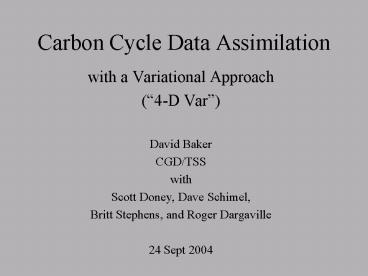Carbon Cycle Data Assimilation - PowerPoint PPT Presentation
Title:
Carbon Cycle Data Assimilation
Description:
Britt Stephens, and Roger Dargaville. 24 Sept 2004. Outline ... Mathematical background of 4-D Var applied to atmospheric trace gases ... – PowerPoint PPT presentation
Number of Views:27
Avg rating:3.0/5.0
Title: Carbon Cycle Data Assimilation
1
Carbon Cycle Data Assimilation
- with a Variational Approach
- (4-D Var)
- David Baker
- CGD/TSS
- with
- Scott Doney, Dave Schimel,
- Britt Stephens, and Roger Dargaville
- 24 Sept 2004
2
Outline
- The problem estimate CO2 sources and sinks at
fine space/time scales (2 x 2.5, hourly/daily) - Method
- Why use 4-D Var? (Kalman) filtering, smoothing,
and variational methods pros and cons - Mathematical background of 4-D Var applied to
atmospheric trace gases - Some 4-D Var results using simulated truth
- Additional topics to ponder
- 100 descent iterations ? 100 ensemble members?
- Error estimates 4-D Var vs. ensemble filters
3
(No Transcript)
4
Transport surface fluxes ? concentrations
0
H?
fluxes
Transport basis functions
concentrations
5
Present ? Future
- Shift towards newer instruments/platforms
- More continuous analyzers, new cheap in situ
analyzers - Aircraft, towers (flux tall), ships/planes of
opportunity - CO2-sondes, tethered balloons, etc.
- Satellite-based column-integrated CO2, maybe CO2
profiles - Higher frequency with better spatial coverage --
will permit more detail to be estimated - More sensitive to continental air, detailed flow
features -- synoptic meteorology, diurnal cycle
must be resolved - Solve for the fluxes at the resolution of the
transport model - 2 x 2.5, 25 levels, daily/hourly time step
- With current inversion techniques, computations
grow as O(N3) more efficient techniques required - (iterative vs. direct inversions, adjoint allows
efficient - gradient computation, minimal storage)
6
For retrospective analyses, a 2-sided smoother
gives more accurate estimates than a 1-sided
filter. The 4-D Var method is 2-sided, like a
smoother.
(Gelb, 1974)
7
Variational Data Assimilation vs. Ensemble
(Kalman) filter
- Pros
- Greater accuracy achieved with 2-sided smoother
than 1-sided filter - Initial transients reduced
- Cons
- Adjoint model required
- Correlations are pre-specified, rather than
calculated, as with a Kalman filter
8
4-D Var Data Assimilation Method
Find optimal fluxes u and initial CO2 field xo to
minimize subject to the dynamical
constraint where x are state variables (CO2
concentrations), v are independent variables
used in model but not optimized, z are the
observations, R is the covariance matrix for
z, uo is an a priori estimate of the fluxes, Puo
is the covariance matrix for uo, xo is an a
priori estimate of the initial concentrations, Pxo
is the covariance matrix for xo
9
4-D Var Data Assimilation Method
Adjoin the dynamical constraints to the cost
function using Lagrange multipliers ? Setting
?F/?xi 0 gives an equation for ?i, the adjoint
of xi The adjoints to the control variables
are given by ?F/?ui and ?F/?xoo as The
optimal u and xo may then be found iteratively by
10
4-D Var Iterative Optimization Procedure
?0
x0
Forward Transport
Forward Transport
True Fluxes
Estimated Fluxes
?1
?2
Modeled Concentrations
True Concentrations
x1
Measurement Sampling
Measurement Sampling
x2
Modeled Measurements
True Measurements
Assumed Measurement Errors
D/(Error)2
?3
x3
Weighted Measurement Residuals
Flux Update
Adjoint Transport
Adjoint Fluxes ?
Minimum of cost function J
11
Prior
Truth
OSSE fluxes, snapshot for Jan 1st
Estimate (30 descent steps)
12
Prior - Truth
Estimate - Truth
13
(No Transcript)
14
(No Transcript)
15
Future Plans for CO2
- Assimilate remotely-sensed data
- Finer resolution (1º x 1º, or regional)
- Improve predictive capability of carbon cycle
models (in two steps) by - Tying fluxes to remotely-sensed patterns
- Estimating parameters in ocean and land biosphere
models using remotely-sensed fields directly as
data
16
Atmospheric transport model
- NASA/GSFC DAO PCTM model
- Lin-Rood advection
- Vertical diffusion
- Simple cloud convection
- Driven by saved wind mixing fields from DAO
analyses - 6-hourly winds interpolated to 15 minute time
step - 2º x 2.5º resolution, 25 vertical levels
- Adjoint
- Coded manually straight-forward because of
- Linearity of CO2 transport
- Simplicity of vertical mixing routines
- Runs as fast as forward code































